Living Landmarks: A Review of Monumental Trees and Their Role in Ecosystems
Abstract
1. Introduction
2. Results and Discussion
2.1. A Bibliometric Review
2.2. Literature Review
2.2.1. Examples of Monumental Trees
2.2.2. Methods for Inventorying Monumental Trees
2.2.3. Guidelines and Methods for the Conservation of Monumental Trees
Inventory Approaches: National and Regional Models
Technological and Scientific Innovations
Guidelines and Conservation Practices
Integrated Perspectives and Future Directions
3. Materials and Methods
4. Conclusions
Author Contributions
Funding
Conflicts of Interest
References
- Reed, J.; van Vianen, J.; Foli, S.; Clendenning, J.; Yang, K.; MacDonald, M.; Petrokofsky, G.; Padoch, C.; Sunderland, T. Trees for life: The ecosystem service contribution of trees to food production and livelihoods in the tropics. For. Policy Econ. 2017, 84, 62–71. [Google Scholar] [CrossRef]
- Dincă, L.; Murariu, G.; Enescu, C.M.; Achim, F.; Georgescu, L.; Murariu, A.; Timiș-Gânsac, V.; Holonec, L. Productivity differences between southern and northern slopes of Southern Carpathians (Romania) for Norway spruce, silver fir, birch and black alder. Not. Bot. Horti Agrobot. Cluj-Napoca 2020, 48, 1070–1084. [Google Scholar] [CrossRef]
- Baeten, L.; Bruelheide, H.; van Der Plas, F.; Kambach, S.; Ratcliffe, S.; Jucker, T.; Allan, E.; Ampoorter, E.; Barbaro, L.; Bastias, C.C.; et al. Identifying the tree species compositions that maximize ecosystem functioning in European forests. J. Appl. Ecol. 2019, 56, 733–744. [Google Scholar] [CrossRef]
- Murariu, G.; Dincă, L.; Tudose, N.; Crișan, V.; Georgescu, L.; Munteanu, D.; Dragu, M.D.; Rosu, B.; Mocanu, G.D. Structural characteristics of the main resinous stands from Southern Carpathians, Romania. Forests 2021, 12, 1029. [Google Scholar] [CrossRef]
- Dincă, L.; Marin, M.; Radu, V.; Murariu, G.; Drașovean, R.; Crețu, R.; Georgescu, L.; Timiș-Gânsac, V. Which are the best site and stand conditions for silver fir (Abies alba Mill.) located in the Carpathian Mountains? Diversity 2022, 14, 547. [Google Scholar] [CrossRef]
- Huang, L.I.; Jin, C.; Zhen, M.; Zhou, L.; Qian, S.; Jim, C.Y.; Lin, D.; Zhao, L.; Minor, J.; Coggins, C.; et al. Biogeographic and anthropogenic factors shaping the distribution and species assemblage of heritage trees in China. Urban For. Urban Green. 2020, 50, 126652. [Google Scholar] [CrossRef]
- Jim, C.Y. Floristics, performance and prognosis of historical trees in the urban forest of Guangzhou City (China). Environ. Monit. Assess. 2005, 102, 285–308. [Google Scholar] [CrossRef]
- Nolan, V.; Reader, T.; Gilbert, F.; Atkinson, N. The ancient tree inventory: A summary of the results of a 15 year citizen science project recording ancient, veteran and notable trees across the UK. Biodivers. Conserv. 2020, 29, 3103–3129. [Google Scholar] [CrossRef]
- Simard, S. Finding the Mother Tree: Discovering the Wisdom of the Forest; Knopf: New York, NY, USA, 2021. [Google Scholar]
- Orlowski, G.; Nowak, L. The importance of marginal habitats for the conservation of old trees in agricultural landscapes. Landsc. Urban Plan. 2007, 79, 77–83. [Google Scholar] [CrossRef]
- Lindenmayer, D.B.; Laurance, W.; Franklin, J.F.; Likens, G.E.; Banks, S.C.; Blanchard, W.; Gibbons, P.; Ikin, K.; Blair, D.; McBurney, L.; et al. New policies for old trees: Averting a global crisis in a keystone ecological structure. Conserv. Lett. 2014, 7, 61–69. [Google Scholar] [CrossRef]
- Hall, S.J.G.; Bunce, R.G.H. Mature trees as keystone structures in Holarctic ecosystems—A quantitative species comparison in a northern English park. Plant Ecol. Divers. 2011, 4, 243–250. [Google Scholar] [CrossRef]
- Read, H. Veteran Trees: A Guide to Good Management; English Nature: Peterborough, UK, 2000; pp. 1–167. [Google Scholar]
- Jim, C.Y.; Zhang, H. Species diversity and spatial differentiation of old-valuable trees in urban Hong Kong. Urban For. Urban Green. 2013, 12, 171–182. [Google Scholar] [CrossRef]
- Huang, L.; Tian, L.; Zhou, L.; Jin, C.; Qian, S.; Jim, C.Y.; Lin, D.; Zhao, L.; Minor, J.; Coggins, C.; et al. Local cultural beliefs and practices promote conservation of large old trees in an ethnic minority region in southwestern China. Urban For. Urban Green. 2020, 49, 126584. [Google Scholar] [CrossRef]
- Cheung, L.T.; Hui, D.L. Influence of residents’ place attachment on heritage forest conservation awareness in a peri-urban area of Guangzhou, China. Urban For. Urban Green. 2018, 33, 37–45. [Google Scholar] [CrossRef]
- Gulgun, B.; Yazici, K.; Dursun, S. Tokat and Amasya cities monumental trees as natural heritage. In Proceedings of the 15th International Multidisciplinary Scientific GeoConference SGEM, Albena, Bulgaria, 18–24 June 2015; pp. 725–732. [Google Scholar]
- Belkayali, N. Identifying and assessing visitor impacts and attitudes: A case study in the Kure Mountains National Park. Fresenius Environ. Bull. 2015, 24, 3044–3056. [Google Scholar]
- Jin, C.; Zheng, M.; Huang, L.; Qian, S.; Jim, C.Y.; Lin, D.; Zhao, L.; Minor, J.; Coggins, C.; Chen, B.; et al. Co-existence between humans and nature: Heritage trees in China’s yangtze River region. Urban For. Urban Green. 2020, 54, 126748. [Google Scholar] [CrossRef]
- Lindenmayer, D.B.; Likens, G.E.; Andersen, A.; Bowman, D.; Bull, C.M.; Burns, E.; Dickman, C.R.; Hoffmann, A.A.; Keith, D.A.; Liddell, M.J.; et al. Value of long-term ecological studies. Austral Ecol. 2012, 37, 745–757. [Google Scholar] [CrossRef]
- Rudl, A.; Machar, I.; Uradnicek, L.; Praus, L.; Pechanec, V. Young urban trees as important structures in the cultural heritage of cities—A case study from Prague. Environ. Socio-Econ. Stud. 2019, 7, 14–23. [Google Scholar] [CrossRef]
- Hou, H.; Zhang, L.; Bi, H.; He, J.; Cai, E.; Ren, W. Differential characteristics and driving forces of the spatial distribution of heritage trees in Luoyang, an ancient capital of China. Front. Environ. Sci. 2022, 10, 993333. [Google Scholar] [CrossRef]
- Dreslerová, J. Memorial trees in the Czech landscape. J. Landsc. Ecol. 2017, 10, 79–108. [Google Scholar] [CrossRef]
- National Environmental Protection Agency. Good Practice Guide for the Design and Maintenance of Green Spaces in Urban Areas; Ministry of Environment: Bucharest, Romania, 2018; Available online: https://www.anpm.ro (accessed on 19 May 2025).
- Oradea City Hall. Regulation on the Organization and Functioning of the Green Spaces Department. Oradea, Romania. 2024. Available online: https://oradea.ro/wp-content/uploads/2024/01/ROF-2016.pdf (accessed on 19 May 2025).
- Yu, H.Y.; Yang, L.L.; Tan, T.H.; Mo, Z.M. Divergent responses of woody plant phenology to seasonal temperature in Dongling mountain of Beijing. For. Res. 2023, 36, 80–90. [Google Scholar]
- Dar, R.A.; Shahnawaz, M.; Qazi, P.H. General overview of medicinal plants: A review. J. Phytopharm. 2017, 6, 349–351. [Google Scholar] [CrossRef]
- Chassagne, F.; Samarakoon, T.; Porras, G.; Lyles, J.T.; Dettweiler, M.; Marquez, L.; Salam, A.M.; Shabih, S.; Farrokhi, D.R.; Quave, C.L. A systematic review of plants with antibacterial activities: A taxonomic and phylogenetic perspective. Front. Pharmacol. 2021, 11, 586548. [Google Scholar] [CrossRef]
- Dincă, L.; Crișan, V.; Ienașoiu, G.; Murariu, G.; Drașovean, R. Environmental indicator plants in mountain forests: A review. Plants 2024, 13, 3358. [Google Scholar] [CrossRef] [PubMed]
- Chen, S.; Chen, J.; Jiang, C.; Yao, R.T.; Xue, J.; Bai, Y.; Wang, H.; Jiang, C.; Wang, S.; Zhong, Y.; et al. Trends in research on forest ecosystem services in the most recent 20 years: A bibliometric analysis. Forests 2022, 13, 1087. [Google Scholar] [CrossRef]
- Timiș-Gânsac, V.; Dincă, L.; Constandache, C.; Murariu, G.; Cheregi, G.; Timofte, C.S.C. Conservation biodiversity in arid areas: A review. Sustainability 2025, 17, 2422. [Google Scholar] [CrossRef]
- Sullivan, A. Bridging the divide between rural and urban community-based forestry: A bibliometric review. Forest Policy and Economics 2022, 144, 102826. [Google Scholar] [CrossRef]
- Dincă, L.; Constandache, C.; Postolache, R.; Murariu, G.; Tupu, E. Timber harvesting in mountainous regions: A comprehensive review. Forests 2025, 16, 495. [Google Scholar] [CrossRef]
- Vasile, D.; Dumitru-Dobre, C.; Coman, S.; Scărlătescu, V.; Breabăn, I.G.; Enescu, R. Assessment of the monumental trees health condition from Brașov area using Arbotom Sonic Tomograph. Present Environ. Sustain. Dev. 2023, 17, 77–84. [Google Scholar] [CrossRef]
- Mejorado Velazco, N.A.; Romo Lozano, J.L.; Villanueva Morales, A.; Borja De la Rosa, A.M. Assessment of monumentality of urban trees in Mexico. Rev. Mex. Cienc. For. 2020, 11, 4–25. [Google Scholar]
- Wang, Y.; Wu, Y.; Sun, Q.; Hu, C.; Liu, H.; Chen, C.; Xiao, P. Tree failure assessment of london plane (Platanus× acerifolia (aiton) willd.) street trees in nanjing city. Forests 2023, 14, 1696. [Google Scholar] [CrossRef]
- Efe, R.; Soykan, A.; Cürebal, İ.; Sönmez, S. Kuyucak Monumental Cretan Maple (Acer sempervirens L.) (Burhaniye–Balıkesir, Turkey). Procedia-Soc. Behav. Sci. 2014, 120, 547–556. [Google Scholar] [CrossRef]
- Ashley, M.V.; Chong, J.P.; Luers, J.; Backs, J.R. The Lonely Life of a Champion Tree, Aesculus glabra. Forests 2022, 13, 1537. [Google Scholar] [CrossRef]
- Píšová, S.; Tokarieva, O.; Sendonin, S. The experience of preserving ancient trees in Vienna, Austria. Ukr. J. For. Wood Sci. 2023, 14, 83. [Google Scholar] [CrossRef]
- Scipioni, M.C. Monumental tree trunks as indicators of forest degradation in southern Brazil. Ciênc. Florest. 2019, 29, 1712–1725. [Google Scholar] [CrossRef]
- Jim, C.Y. Evaluation of heritage trees for conservation and management in Guangzhou city (China). Environ. Manag. 2004, 33, 74–86. [Google Scholar] [CrossRef]
- Crzywacz, A.; Keczyński, A.; Szczepkowski, A.; Bielak, K.; Bolibok, L.; Buraczyk, W.; Drozdowski, S.; Gawron, L.; Szeligowski, H.; Zajączkowski, J.; et al. Monumental trees in the Strict Reserve of the Białowieża National Park. Sylwan 2019, 162, 915–926. [Google Scholar]
- Temel, F.; Ozalp, M. Monumental Castanea sativa Mill. individuals on the slopes of Genya Mountain, Artvin, Turkey. Acta Hortic. 2007, 815, 171–178. [Google Scholar] [CrossRef]
- Krebs, P.; Conedera, M.; Fonti, P. The inventory of the giant chestnut trees in Southern Switzerland. Acta Hortic. 2005, 693, 171. [Google Scholar] [CrossRef]
- Gaspar Bernárdez Villegas, J.; Rigueiro Rodríguez, A.; Silva de la Iglesia, I. Monumental Sweet Chestnuts (Castanea sativa Mill.) in Galicia’s Cultural Landscape (NW Spain). Landscapes 2021, 22, 147–172. [Google Scholar] [CrossRef]
- Genc, M.; Guner, Ş.T. A new monumental chestnut (Castanea sativa Mill.) stand found in Isparta. Turk. J. Agric. For. 2000, 24, 37–44. [Google Scholar]
- Schicchi, R.; Speciale, C.; Amato, F.; Bazan, G.; Di Noto, G.; Marino, P.; Geraci, A. The monumental olive trees as biocultural heritage of Mediterranean landscapes: The case study of Sicily. Sustainability 2021, 13, 6767. [Google Scholar] [CrossRef]
- Fernández-Lorenzo, J.L.; Couso, A.; Mosquera, R.; Rigueiro, A.; Zeljković, S. Establishment of in vitro accessions of two Galician monumental chestnut trees. Book Proc. 2024, 27, 42. [Google Scholar] [CrossRef]
- Tokarieva, O.; Kushnir, A.; Sendonin, S.; Yavnyi, M.; Kurylo, O. Monumental trees of Ukraine and public awareness of them. Ukr. J. For. Wood Sci. 2024, 2, 153–169. [Google Scholar] [CrossRef]
- Petino, G.; Chinnici, G.; Privitera, D. Heritage and carob trees: Where the monumental and landscape intersect. AIMS Geosci. 2024, 10, 623–640. [Google Scholar] [CrossRef]
- Verschuren, L.; De Mil, T.; De Frenne, P.; Haneca, K.; Van Acker, J.; Vandekerkhove, K.; Van den Bulcke, J. Heading for a fall: The fate of old wind-thrown beech trees (Fagus sylvatica) is detectable in their growth pattern. Sci. Total Environ. 2023, 903, 166148. [Google Scholar] [CrossRef]
- Lai, P.Y.; Jim, C.Y.; Da Tang, G.; Hong, W.J.; Zhang, H. Spatial differentiation of heritage trees in the rapidly-urbanizing city of Shenzhen, China. Landsc. Urban Plan. 2019, 181, 148–156. [Google Scholar] [CrossRef]
- Li, K.; Zhang, G. Species diversity and distribution pattern of heritage trees in the rapidly-urbanizing province of Jiangsu, China. Forests 2021, 12, 1543. [Google Scholar] [CrossRef]
- Kurtaslan, B.O.; Pirselimoglu, Z.; Demirel, O. Twelve monumental trees in a forest area in Artvin, Turkey: Their legal status and protection problems. Energy Educ. Sci. Technol. Part B Soc. Educ. Stud. 2012, 185–196. [Google Scholar]
- Liu, J.; Yang, B.; Lindenmayer, D.B. The oldest trees in China and where to find them. Front. Ecol. Environ. 2019, 17, 319–322. [Google Scholar] [CrossRef]
- Fuster, M.G.; Sadornil, E. The age of monumental trees. A case study of Juniperus thurifera L. in Spain. For. Syst. 2020, 29, e007. [Google Scholar] [CrossRef]
- Meller, M.; Bernat, S. Monument trees in the area of health resorts in Poland. Sylwan 2019, 163, 258–264. [Google Scholar]
- Camarero, J.J.; Touchan, R.; Valeriano, C.; Bashour, I.; Stephan, J. Dating the Noah trees to improve age estimates in centennial and millennial olive trees. Dendrochronologia 2024, 84, 126181. [Google Scholar] [CrossRef]
- Arnan, X.; López, B.C.; Martínez-Vilalta, J.; Estorach, M.; Poyatos, R. The age of monumental olive trees (Olea europaea) in northeastern Spain. Dendrochronologia 2012, 30, 11–14. [Google Scholar] [CrossRef]
- Marchese, A.; Bonanno, F.; Marra, F.P.; Trippa, D.A.; Zelasco, S.; Rizzo, S.; Giovino, A.; Imperiale, V.; Ioppolo, A.; Sala, G.; et al. Recovery and genotyping ancient Sicilian monumental olive trees. Front. Conserv. Sci. 2023, 4, 1206832. [Google Scholar] [CrossRef]
- Bombarely, A.; Doulis, A.G.; Lambrou, K.K.; Zioutis, C.; Margaritis, E.; Koubouris, G. Elucidation of the origin of the monumental olive tree of Vouves in Crete, Greece. Plants 2021, 10, 2374. [Google Scholar] [CrossRef] [PubMed]
- Anestiadou, K.; Nikoloudakis, N.; Hagidimitriou, M.; Katsiotis, A. Monumental olive trees of Cyprus contributed to the establishment of the contemporary olive germplasm. PLoS ONE 2017, 12, e0187697. [Google Scholar] [CrossRef]
- Yang, Y.; Sang, S.; Liu, F.; Xu, Y.; Jiang, Z.; Liu, X. Species diversity and spatial differentiation of heritage trees in Chengdu, China. Front. Ecol. Evol. 2024, 12, 1413596. [Google Scholar] [CrossRef]
- Nowakowska, J.A.; Hsiang, T.; Patynek, P.; Stereńczak, K.; Olejarski, I.; Oszako, T. Health assessment and genetic structure of monumental Norway spruce trees during a bark beetle (Ips typographus L.) outbreak in the Białowieża Forest District, Poland. Forests 2020, 11, 647. [Google Scholar] [CrossRef]
- Yaman, B.; Sarıbaș, M. Elemen Black Pine, a new monumental tree in Dirgine forests Zonguldak. Ekoloji 2007, 16, 62–68. [Google Scholar]
- Bernardini, V.; Avolio, S.; Plutino, M. Pinus nigra J.F. Arnold subsp. calabrica (Poir.) of the Fallistro Biogenetic Natural Reserve: State of “Giant pines” stand after 40 years of observations. For. Syst. 2020, 29, 196–205. [Google Scholar]
- Marchica, A.; Pellegrini, L.; Remorini, D.; Massai, R.; Lorenzini, G. Age matters: The struggle for life of a monumental tree. Agrochimica 2017, 61, 110–122. [Google Scholar] [CrossRef]
- Millán, J.M.B.; Daniëls, P.J.P.; Vidal, I.A.; Zabia, J.L.; Martín, D.M.; Martín, L.Ó.A.; Derqui, C.C. Assessing Biodiversity Associated with Four Monumental Trees in Madrid Region (Spain). Arboric. Urban For. (AUF) 2025, 51, 252–273. [Google Scholar]
- Yener, S.D. Development of protection strategies for monumental and veteran plane trees in Istanbul. Fresenius Environ. Bull. 2022, 31, 2320–2330. [Google Scholar]
- Kagiali, C.S.; Tsitsoni, T.K. Monumental trees in the Historic Centre of Thessaloniki: Highlighting them through a cultural route. In Proceedings of the 5th Annual Conference of the Balkan Universities Association, Thessaloniki, Greece, 16–18 April 2019; pp. 16–18. [Google Scholar]
- Grigoriadis, N.; Kagiali, C.; Koutsianitis, D.; Kechagia, T.; Papaioannou, E.; Grigoriadis, S.; Barboutis, I. Risk Assessment and Dendrochronology of Monumental Plane Trees in the Municipality of Thessaloniki. Int. J. Adv. Eng. Manag. (IJAEM) 2021, 3, 431–438. [Google Scholar]
- Pietraszko, E.; Żarnowiec, J.; Szafran, S.; Zalot, T.; Dziergas, G.; Jarosz, P. What can we learn from monitoring of monumental trees—A case study of the Jasienica and Jaworze Communes (Silesia, South Poland). J. Ecol. Eng. 2022, 23, 129–138. [Google Scholar] [CrossRef] [PubMed]
- Kimic, K. Pear trees (Pyrus communis L.) as monuments of nature in Warsaw public spaces—State of preservation. In Proceedings of the Public Recreation and Landscape Protection—With Sense Hand in Hand, Online, 10–11 May 2021; pp. 349–353. [Google Scholar]
- Efe, R.; Soykan, A.; Curebal, I.; Sonmez, S. Dede Korkut monument oak (Quercus infectoria Olivier) (Kadıköy–Edremit–Balıkesir, Turkey). Procedia-Soc. Behav. Sci. 2011, 19, 627–636. [Google Scholar] [CrossRef]
- Gül, A.U.; Gümüş, C.; Yavuz, H.; Eroğlu, M.; Özkan, Z.C.; Demirci, A. Monumental Trees and Stands in the Black Sea Region. Turk. J. Agric. For. 1999, 23, 671–678. [Google Scholar]
- Prokopuk, Y.; Leshcheniuk, O.; Sukhomlyn, M.; Matiashuk, R.; Budzhak, V.; Netsvetov, M. Growth drivers of monumental wild service tree (Sorbus torminalis) out of its natural range in Kyiv, Ukraine. Dendrobiology 2022, 87, 163–170. [Google Scholar] [CrossRef]
- Malliarou, E.; Avramidou, E.V.; Ranis, G.D.; Bountis, D.I. Towards the conservation of monumental Taxus baccata L. trees of Thasos Island: Genetic insights. Forests 2023, 14, 2384. [Google Scholar] [CrossRef]
- Benner, J.; Knudby, A.; Nielsen, J.; Krawchuk, M.; Lertzman, K. Combining data from field surveys and archaeological records to predict the distribution of culturally important trees. Divers. Distrib. 2019, 25, 1375–1387. [Google Scholar] [CrossRef]
- Pan, Y.; Wang, S.; Xie, C.; Jim, C.Y. Species diversity and spatial pattern of heritage trees in Taiyuan. Sci. Rep. 2025, 15, 17584. [Google Scholar] [CrossRef] [PubMed]
- Díez, C.M.; Trujillo, I.; Barrio, E.; Belaj, A.; Barranco, D.; Rallo, L. Centennial olive trees as a reservoir of genetic diversity. Ann. Bot. 2011, 108, 797–807. [Google Scholar] [CrossRef] [PubMed]
- Ninot, A.; Howad, W.; Aranzana, M.J.; Senar, R.; Romero, A.; Mariotti, R.; Baldoni, L.; Belaj, A. Survey of over 4,500 monumental olive trees preserved on-farm in the northeast Iberian Peninsula, their genotyping and characterization. Sci. Hortic. 2018, 231, 253–264. [Google Scholar] [CrossRef]
- Cicatelli, A.; Fortunati, T.; De Feis, I.; Castiglione, S. Oil composition and genetic biodiversity of ancient and new olive (Olea europaea L.) varieties and accessions of southern Italy. Plant Sci. 2013, 210, 82–92. [Google Scholar] [CrossRef]
- Salimonti, A.; Simeone, V.; Cesari, G.; Lamaj, F.; Cattivelli, L.; Perri, E.; Desiderio, F.; Fanizzi, F.P.; Del Coco, L.; Zelasco, S. A first molecular investigation of monumental olive trees in Apulia region. Sci. Hortic. 2013, 162, 204–212. [Google Scholar] [CrossRef]
- Cherubini, P.; Humbel, T.; Beeckman, H.; Gaertner, H.; Mannes, D.; Pearson, C.; Schoch, W.; Tognetti, R.; Lev-Yadun, S.; Smith, V.C. Olive tree-ring problematic dating: A comparative analysis on Santorini (Greece). PLoS ONE 2013, 8, e54730. [Google Scholar] [CrossRef]
- Lazović, B.; Adakalić, M.; Pucci, C.; Perović, T.; Bandelj, D.; Belaj, A.; Mariotti, R.; Baldoni, L. Characterizing ancient and local olive germplasm from Montenegro. Sci. Hortic. 2016, 209, 117–123. [Google Scholar] [CrossRef]
- Barazani, O.; Westberg, E.; Hanin, N.; Dag, A.; Kerem, Z.; Tugendhaft, Y.; Hmidat, M.; Hijawi, T.; Kadereit, J.W. A comparative analysis of genetic variation in rootstocks and scions of old olive trees—A window into the history of olive cultivation practices and past genetic variation. BMC Plant Biol. 2014, 14, 146. [Google Scholar] [CrossRef]
- Petruccelli, R.; Giordano, C.; Salvatici, M.C.; Capozzoli, L.; Ciaccheri, L.; Pazzini, M.; Lain, O.; Testolin, R.; Cimato, A. Observation of eight ancient olive trees (Olea europaea L.) growing in the Garden of Gethsemane. Comptes Rendus Biol. 2014, 337, 311–317. [Google Scholar] [CrossRef]
- Mnasri, S.R.; Montemurro, C.; Miazzi, M.M.; Debbabi, O.S. Unveiling the genetic diversity of Tunisian monumental olive trees to enhance the olive sector. Horticulturae 2025, 11, 147. [Google Scholar] [CrossRef]
- Baldoni, L.; Cultrera, N.G.; Mariotti, R.; Ricciolini, C.; Arcioni, S.; Vendramin, G.G.; Buonamici, A.; Porceddu, A.; Sarri, V.; Ojeda, M.A.; et al. A consensus list of microsatellite markers for olive genotyping. Mol. Breed. 2009, 24, 213–231. [Google Scholar] [CrossRef]
- Vettraino, A.M.; Luchi, N.; Rizzo, D.; Pepori, A.L.; Pecori, F.; Santini, A. Rapid diagnostics for Gnomoniopsis smithogilvyi (syn. Gnomoniopsis castaneae) in chestnut nuts: New challenges by using LAMP and real-time PCR methods. AMB Express 2021, 11, 105. [Google Scholar] [CrossRef] [PubMed]
- Pezzi, G.; Gambini, S.; Buldrini, F.; Ferretti, F.; Muzzi, E.; Maresi, G.; Nascimbene, J. Contrasting patterns of tree features, lichen, and plant diversity in managed and abandoned old-growth chestnut orchards of the northern Apennines (Italy). For. Ecol. Manag. 2020, 470, 118207. [Google Scholar] [CrossRef]
- Butler, J.; Rose, F.; Green, T. Ancient trees, icons of our most important wooded landscapes in Europe. In Tools for Preserving Woodland Biodiversity; Read, H., Forfang, A., Marciau, R., Paltto, H., Andersson, L., Tardy, B., Eds.; NACONEX: Töreboda, Sweden, 2001; pp. 20–26. [Google Scholar]
- American Forests. Available online: https://www.americanforests.org/ (accessed on 12 May 2025).
- Culbert, D.F.; Ward, D.B. Tracking Florida’s Champion Trees. Proc. Fla. State Hortic. Soc. 1997, 110, 393–395. [Google Scholar]
- Gangloff, D.J. The National Register of Big Trees. Arboric. J. 1990, 14, 149–154. [Google Scholar] [CrossRef]
- Braham, R. Updating North Carolina’s Register of Big Trees: NC Champion Big Tree Program. Ph.D. Thesis, North Carolina State University, Raleigh, NC, USA, 2005. [Google Scholar]
- Jim, C.Y. Champion Trees in Urban Hong Kong; Urban Services Department: Hong Kong, China, 1994; p. 19960603152. [Google Scholar]
- Mc Loughlin, J. Irish tree champions. Ir. For. 2022, 77, 143–146. [Google Scholar]
- Gutiérrez, Á.G. Monumental trees: A natural patrimony not yet recognized in Chile. Rev. Bosque 2016, 37, 445–449. [Google Scholar] [CrossRef]
- Kühn, U.; Kühn, S.; Ullrich, B. Bäume die Geschichten Erzählen; BLV Buchen Verlag GmbH & Co. KG: München, Germany, 2005. [Google Scholar]
- Gomolka, A. Das Projekt Rekordbäume/Champion-Trees in Deutschland. Mitteilungen Dtsch. Dendrol. Ges. 2017, 102, 261–269. [Google Scholar]
- Monumental Trees. Available online: https://www.monumentaltrees.com (accessed on 12 May 2025).
- Genç, M.; Güner, Ş.T. A new method to select monumental tree among the forest tree species of Turkey: An application. In Proceedings of the International Conference on Forest Research: A Challenge for Integrated European Approach, Thessaloniki, Greece, 27 August–1 September 2001; Volume 27, pp. 1–6. [Google Scholar]
- Seker, D.Z.; Sivri, N.; Demir, M.; Baytimur, A.; Gunduz, E.; Eroglu, M.F. GIS based inventory and documentation of monumental trees in Black Sea region of Turkey. Fresenius Environ. Bull. 2019, 28, 524–528. [Google Scholar]
- Masini, N.; Strano, G.; Fiorentino, C.; Conte, D.; Abate, N.; Loperte, A.; Amodio, A.M.; Russo, A.; Donvito, A.; Lasaponara, R. From Space to Tree: Multisensor and multiscale remote sensing based approach for monitoring monumental trees. In Proceedings of the International Conference on Metrology for Archaeology and Cultural Heritage, Rome, Italy, 19–21 October 2023; pp. 181–185. [Google Scholar]
- Durlak, W.; Dudkiewicz, M.; Milecka, M. A combined method of senile trees inventory in sustainable urban greenery management on the example of the city of Sandomierz (Poland). Land 2022, 11, 1914. [Google Scholar] [CrossRef]
- Kubus, M. The evaluation of using resistograph when specifying the health condition of a monumental tree. Not. Bot. Horti Agrobot. Cluj-Napoca 2009, 37, 157–164. [Google Scholar]
- Asciuto, A.; Borsellino, V.; D’Acquisto, M.; Franco, C.D.; Gesaro, M.D.; Schimmenti, E. Monumental trees and their existence value: Case study of an Italian natural park. J. For. Sci. 2015, 61, 56–61. [Google Scholar] [CrossRef]
- Regione Puglia. Available online: https://www.regione.puglia.it/web/rigenerazione-olivicola (accessed on 5 May 2025).
- Pinto, D.; Braga, N.; Silva, A.M.; Costa, P.; Delerue-Matos, C.; Rodrigues, F. Chestnut. In Valorization of Fruit Processing By-Products; Academic Press: Cambridge, MA, USA, 2020; pp. 127–144. [Google Scholar]
- Bortolotti, L. The protection of monumental trees. In The Monumental Trees of Italy. The South and the Islands; Edizioni Abete: Roma, Italy, 1989; pp. 287–290. [Google Scholar]
- Wilkaniec, A.; Borowiak-Sobkowiak, B.; Irzykowska, L.; Breś, W.; Świerk, D.; Pardela, Ł.; Durak, R.; Środulska-Wielgus, J.; Wielgus, K.; Koch, F.H. Biotic and abiotic factors causing the collapse of Robinia pseudoacacia L. veteran trees in urban environments. PLoS ONE 2021, 16, e0245398. [Google Scholar] [CrossRef] [PubMed]
- Lonsdale, D. Review of oak mildew, with particular reference to mature and veteran trees in Britain. Arboric. J. 2015, 37, 61–84. [Google Scholar] [CrossRef]
- Jacobsen, R.M.; Birkemoe, T.; Evju, M.; Skarpaas, O.; Sverdrup-Thygeson, A. Veteran trees in decline: Stratified national monitoring of oaks in Norway. For. Ecol. Manag. 2023, 527, 120624. [Google Scholar] [CrossRef]
- Wessolly, L.; Erb, M. Handbuch der Baumstatik und Baumkontrolle; Patzer-Verlag Publishing House: Berlin/Hannover, Germany, 1998; pp. 4–29. [Google Scholar]
- Swoczyna, T.; Kalaji, H.M.; Pietkiewicz, S.; Borowski, J.; Zaraś-Januszkiewicz, E. Monitoring young urban trees tolerance to roadside conditions by application of chlorophyll fluorescence technique. Zesz. Probl. Postęp. Nauk. Rol. 2010, 545, 303–309. [Google Scholar]
- Faison, E.K. Large old tree declines at broad scales: A more complicated story. Conserv. Lett. 2014, 7, 70–71. [Google Scholar] [CrossRef]
- Piovesan, G.; Biondi, F. On tree longevity. New Phytol. 2021, 231, 1318–1337. [Google Scholar] [CrossRef]
- Oktan, E.; Atar, N. Cutting propagation in common yew (Taxus baccata L.): A case study from a monumental tree. Fresenius Environ. Bull. 2021, 30, 8855–8860. [Google Scholar]
- Sladonja, B.; Damijanić, D.; Uzelac, M.; Poljuha, D. Catalogue of super-trees in Istria (Croatia) created as a result of the citizen science action. Front. Environ. Sci. 2023, 11, 1154101. [Google Scholar] [CrossRef]
- Lindenmayer, D.B.; Laurance, W. The ecology, distribution, conservation and management of large old trees. Biol. Rev. 2017, 92, 1434–1458. [Google Scholar] [CrossRef] [PubMed]
- Petruccelli, R.; Giordano, C.; Salvatici, M.C.; Beghè, D.; Rodolfi, M.; Fabbri, A.; Benelli, C. Characterization and conservation of “Olivo della Strega”: An ancient olive tree, precious resource for natural and cultural heritage. Rend. Lincei. Sci. Fis. Nat. 2021, 32, 311–324. [Google Scholar] [CrossRef]
- Ramón Fernández, F. La protección del patrimonio arbóreo monumental en la legislación española. Su aplicación al turismo y al paisaje. Ius Prax. 2018, 24, 109–132. [Google Scholar]
- Zapponi, L.; Mazza, G.; Farina, A.; Fedrigoli, L.; Mazzocchi, F.; Roversi, P.F.; Peverieri, G.S.; Mason, F. The role of monumental trees for the preservation of saproxylic biodiversity: Re-thinking their management in cultural landscapes. Nat. Conserv. 2017, 243, 231–243. [Google Scholar] [CrossRef]
- Villota, M.G. Estado actual de la legislación autonómica de los árboles singulares: Del concepto a la protección. Cuad. Soc. Esp. Cienc. For. 2018, 44, 61–76. [Google Scholar]
- Oleksiichenko, N.; Pidkhovna, S. The old-age trees of the parks-monuments as park and garden art objects in Ternopil region. Proc. For. Acad. Sci. Ukr. 2018, 16, 41–49. [Google Scholar]
- Pietrzak-Zawadka, J. Protection of trees—Monuments of nature in selected European countries. Zarz. Ochr. Przyr. Lasach 2016, 10, 17–28. [Google Scholar]
- Kushnir, A.I.; Vakulyk, I.I. Value of unique old trees—A natural monument. Biol. Resour. Nat. Manag. 2018, 10, 176–182. [Google Scholar] [CrossRef]
- Ţenche-Constantinescu, A.M.; Madoşa, E.; Chira, D.; Hernea, C.; Ţenche-Constantinescu, R.V.; Lalescu, D.; Borlea, G.F. Tilia sp.—Urban trees for the future. Not. Bot. Horti Agrobot. Cluj-Napoca 2015, 43, 259–264. [Google Scholar] [CrossRef]
- Chira, D.; Bolea, V.; Chira, F.; Mantale, C.; Tăut, I.; Şimonca, V.; Diamandis, S. Biological control of Cryphonectria parasitica in Romanian protected sweet chestnut forests. Not. Bot. Horti Agrobot. Cluj-Napoca 2017, 45, 632–638. [Google Scholar] [CrossRef]
- Fernandez-Fernandez, M.; Naves, P.; Musolin, D.L.; Selikhovkin, A.V.; Cleary, M.; Chira, D.; Paraschiv, M.; Gordon, T.; Solla, A.; Papazova-Anakieva, I.; et al. Pine pitch canker and insects: Regional risks, environmental regulation, and practical management options. Forests 2019, 10, 649. [Google Scholar] [CrossRef]
- Dudkiewicz, M.; Durlak, W. Sustainable management of very large trees with the use of acoustic tomography. Sustainability 2021, 13, 12315. [Google Scholar] [CrossRef]
- Mang, S.M.; Marcone, C.; Camele, I. Fungal diversity in chestnut galls induced by Dryocosmus kuriphilus from Basilicata Region (Southern Italy). Ann. For. Res. 2024, 67, 115–130. [Google Scholar] [CrossRef]
- Clemente, M.; Pignatti, G.; Degaetano, M.; Corona, P. A “Street Tree” Master Plan for the Strategic Management of Linear Reforestation and Urban Landscape Enhancement in Rome, Italy. Land 2025, 14, 606. [Google Scholar] [CrossRef]
- Pesenti, L. Managing Xylella fastidiosa in Europe: Exploring Biocontrol Strategies. Plant Health Cases 2025, phcs20250009. [Google Scholar] [CrossRef]
- Şimonca, V.; Oroian, I.; Chira, D.; Tăut, I. Methods for quantification of the decline phenomenon and determination of the vulnerability degree for the oak stands in Northwestern Transylvania, Romania. Not. Bot. Horti Agrobot. Cluj-Napoca 2017, 45, 623–631. [Google Scholar] [CrossRef]
- Tsopelas, P.; Santini, A.; Wingfield, M.J.; Wilhelm de Beer, Z. Canker stain: A lethal disease destroying iconic plane trees. Plant Dis. 2017, 101, 645–658. [Google Scholar] [CrossRef]
- Fernández-Fernández, M.; Naves, P.; Witzell, J.; Musolin, D.L.; Selikhovkin, A.V.; Paraschiv, M.; Chira, D.; Martínez-Álvarez, P.; Martín-García, J.; Muñoz-Adalia, E.J.; et al. Pine pitch canker and insects: Relationships and implications for disease spread in Europe. Forests 2019, 10, 627. [Google Scholar] [CrossRef]
- Mang, S.; Marcone, C.; Marcone, M.; Chira, D.; Chira, F.; Maxim, A.; Camele, I. Molecular characterisation of Cryphonetria parasitica isolates from Basilicata region (Southern Italy) and mycovirus identification. J. Biol. Res.-Boll. Soc. Ital. Biol. Sper. 2024, 98/1. [Google Scholar] [CrossRef]
- Bebber, D.P.; Maclean, I.M.; Mosedale, J.R.; Youngman, B.D. Potential impacts of plant pests and diseases on trees and forests in the United Kingdom. Plants People Planet 2025, 1–13. [Google Scholar] [CrossRef]
- Li, E.; Luo, H.; Cui, X.; Liu, K.; Dong, W. Future climate change promotes the global threat of the emerald ash borer (Agrilus planipennis Fairmaire) to ash species. J. Plant Ecol. 2025, rtaf091. [Google Scholar] [CrossRef]
- Vagelas, I.; Michail, G.; Madesis, P. Pests and Diseases: A Global Threat to Plants. In Microbial Biostimulants; Apple Academic Press: Cambridge, MA, USA, 2025; pp. 1–29. [Google Scholar]
- Qu, L.; Li, J.; Wang, R.; Wang, X.; Zhao, T.; Chen, Y.; Wang, L. Metabolic and transcriptional profiling of Fraxinus chinensis var. rhynchophylla unravels possible constitutive resistance against Agrilus planipennis. Forests 2021, 12, 1373. [Google Scholar]
- Chira, D.; Borlea, F.G.; Chira, F.; Mantale, C.Ș.; Ciocîrlan, M.I.; Turcu, D.O.; Cadar, N.; Trotta, V.; Camele, I.; Marcone, C.; et al. Selection of elms tolerant to Dutch elm disease in south-west Romania. Diversity 2022, 14, 980. [Google Scholar] [CrossRef]
- Mageroy, M.H.; Nagy, N.E.; Steffenrem, A.; Krokene, P.; Hietala, A.M. Conifer defences against pathogens and pests—Mechanisms, breeding, and management. Curr. For. Rep. 2023, 9, 429–443. [Google Scholar] [CrossRef]
- Ciocîrlan, M.I.C.; Ciocîrlan, E.; Radu, R.G.; Chira, D.; Gailing, O.; Vînătoru, C.; Grigoriadou-Zormpa, O.; Vucetic, B.; Budde, K.B.; Florea, S.; et al. Exploring the association between adaptive and growth traits and within-individual genetic diversity in common beech (Fagus sylvatica). Ann. For. Res. 2024, 67, 151–166. [Google Scholar] [CrossRef]
- Carlucci, M.; Savoia, M.A.; Lucchese, P.G.; Fanelli, V.; Mascio, I.; Aurelio, F.L.; Miazzi, M.M.; Pacifico, A.; Montemurro, C.; Nigro, F. Behavior of Olive Genotypes Against Quick Decline Syndrome (QDS) Caused by Xylella fastidiosa subsp. pauca in Apulia. Plants 2025, 14, 157. [Google Scholar] [CrossRef]
- Dinca, L.; Crisan, V.; Murariu, G.; Hahuie, V. The economic value of forest fruits. A bibliometric analysis researched during the period of 1978 to 2023. Sci. Pap. Ser. Manag. Econ. Eng. Agric. Rural. Dev. 2025, 25, 273–283. [Google Scholar]
- Tomao, A.; Secondi, L.; Corona, P.; Giuliarelli, D.; Quatrini, V.; Agrimi, M. Can composite indices explain multidimensionality of tree risk assessment? A case study in an historical monumental complex. Urban For. Urban Green. 2015, 14, 456–465. [Google Scholar] [CrossRef]
- Blicharska, M.; Mikusiński, G. Incorporating social and cultural significance of large old trees in conservation policy. Conserv. Biol. 2014, 28, 1558–1567. [Google Scholar] [CrossRef]
- Apostol, E.N.; Stuparu, E.; Scarlatescu, V.; Budeanu, M. Testing Hungarian oak (Quercus frainetto Ten.) provenances in Romania. iForest 2020, 13, 9–15. [Google Scholar] [CrossRef]
- Besliu, E.; Curtu, A.L.; Apostol, E.N.; Budeanu, M. Using adapted and productive European beech (Fagus sylvatica L.) provenances as future solutions for sustainable forest management in Romania. Land 2024, 13, 183. [Google Scholar] [CrossRef]
- Budeanu, M.; Şofletea, N.; Petriţan, I.C. Among-population variation in quality traits in two Romanian provenance trials with Picea abies L. Balt. For. 2014, 20, 37–47. [Google Scholar]
- Budeanu, M.; Besliu, E.; Pepelea, D. Testing the radial increment and climate–growth relationship between Swiss stone pine European provenances in the Romanian Carpathians. Forests 2025, 16, 391. [Google Scholar] [CrossRef]
- Wu, M.; Tian, D.; Shi, L.; Xu, C.; Mo, Y.; Zhang, G.; Gao, Y. Suitable Tree Species for Afforestation in Semiarid China: Evidence from Tree Stem Growth Monitoring. Forests 2025, 16, 50. [Google Scholar] [CrossRef]
- Jia, Y.; Liu, J.; Zhao, W.; Zhang, Y.; Wang, Z.; Li, M. Evolutionary Legacy of a Forest Plantation Tree Species (Pinus armandii): Implications for Widespread Afforestation. Evol. Appl. 2020, 13, 1234–1246. [Google Scholar] [CrossRef]
- Pan, X.; Shan, Z.; Tian, X.; Niu, Y.; Liu, Y.; Li, Z.; Li, Y.; Huang, Y.; Ye, J. Evaluating Conservation Gaps of China’s National Key Protected Wild Plants: Insights from County-Level Distribution Data. BMC Biol. 2025, 23, 156. [Google Scholar] [CrossRef]
- Wang, X.R.; Szmidt, A.E.; Lu, M.Z. Genetic Variation and Conservation Assessment of Chinese Populations of Magnolia cathcartii—A Rare Evergreen Tree. Mol. Genet. Genom. 2003, 270, 78–85. [Google Scholar]
- Wang, S.Q. Genetic Diversity and Population Structure of the Endangered Paeonia decomposita Endemic to China and Implications for Conservation. BMC Plant Biol. 2020, 20, 510. [Google Scholar] [CrossRef]
- FAO. Forestry in China. In Forestry Outlook Study for Asia and the Pacific; FAO: Rome, Italy, 2003; Available online: https://www.fao.org/3/y9882e/y9882e08.htm (accessed on 24 June 2025).
- Salisbury, L. Web of Science and Scopus: A comparative review of content and searching capabilities. Charlest. Advis. 2009, 11, 5–18. [Google Scholar]
- Adriaanse, L.; Rensleigh, C. Web of Science, Scopus and Google Scholar: A content comprehensiveness comparison. Electron. Libr. 2013, 31, 727–744. [Google Scholar] [CrossRef]
- Clarivate.com. Web of Science Core Collection. 2024. Available online: https://clarivate.com/products/scientific-and-academic-research/research-discovery-and-workflow-solutions/webofscience-platform/web-of-science-core-collection/ (accessed on 21 March 2025).
- Geochart. Available online: https://developers.google.com/chart/interactive/docs/gallery/geochart (accessed on 25 March 2025).
- Microsoft.com. Microsoft Excel. 2024. Available online: https://www.microsoft.com/en-us/microsoft-365/excel?legRedir=true&CorrelationId=3bb60ab0-fe13-41a4-812b-2627667cf346 (accessed on 28 March 2025).
- VOSviewer. Available online: https://www.vosviewer.com/ (accessed on 25 March 2025).
- Page, M.J.; McKenzie, J.E.; Bossuyt, P.M.; Boutron, I.; Hoffmann, T.C.; Mulrow, C.D.; Shamseer, L.; Tetzlaff, J.M.; Akl, E.A.; Brennan, S.E.; et al. The PRISMA 2020 Statement: An Updated Guideline for Reporting Systematic Reviews. BMJ 2021, 372, n71. [Google Scholar] [CrossRef] [PubMed]
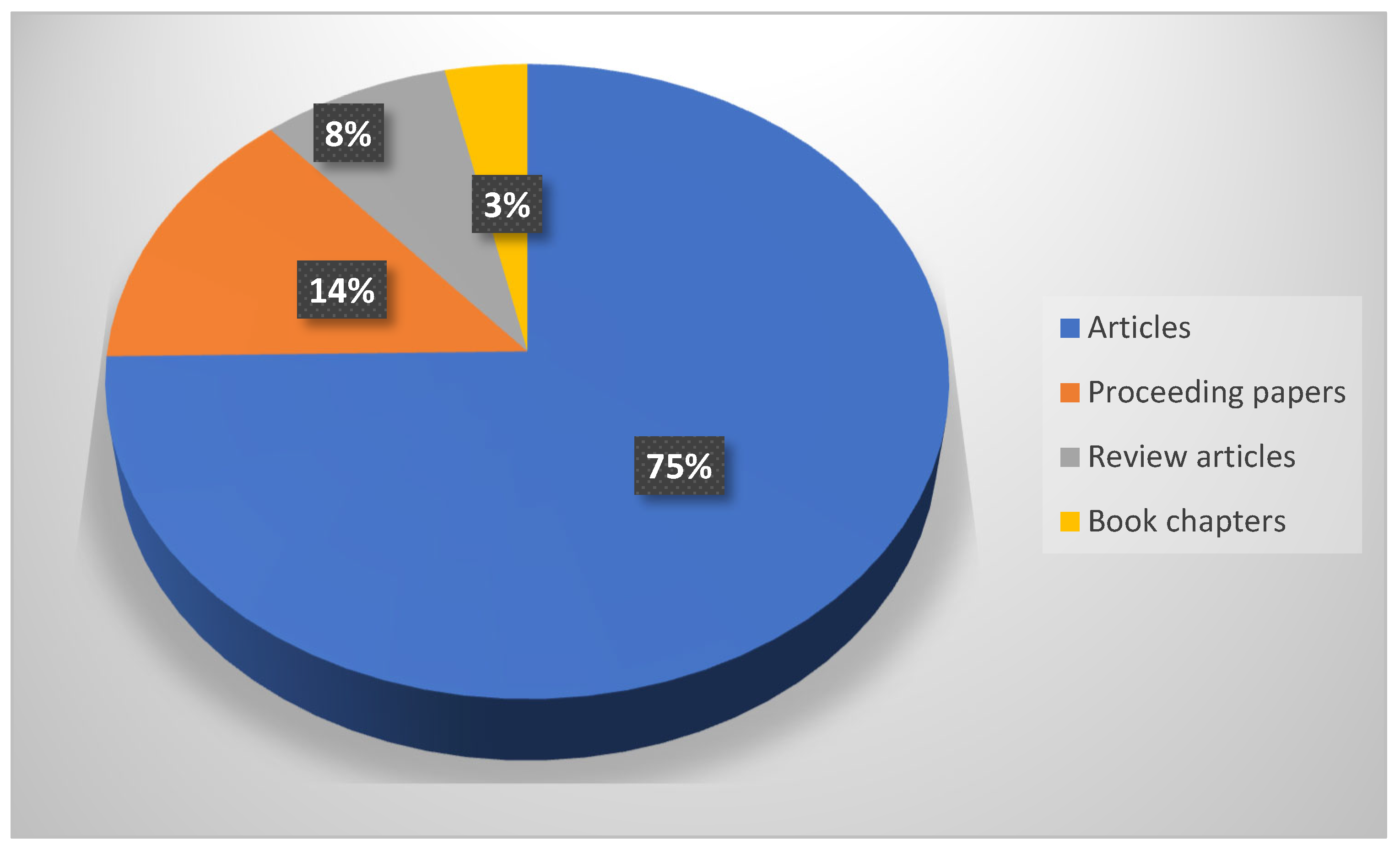

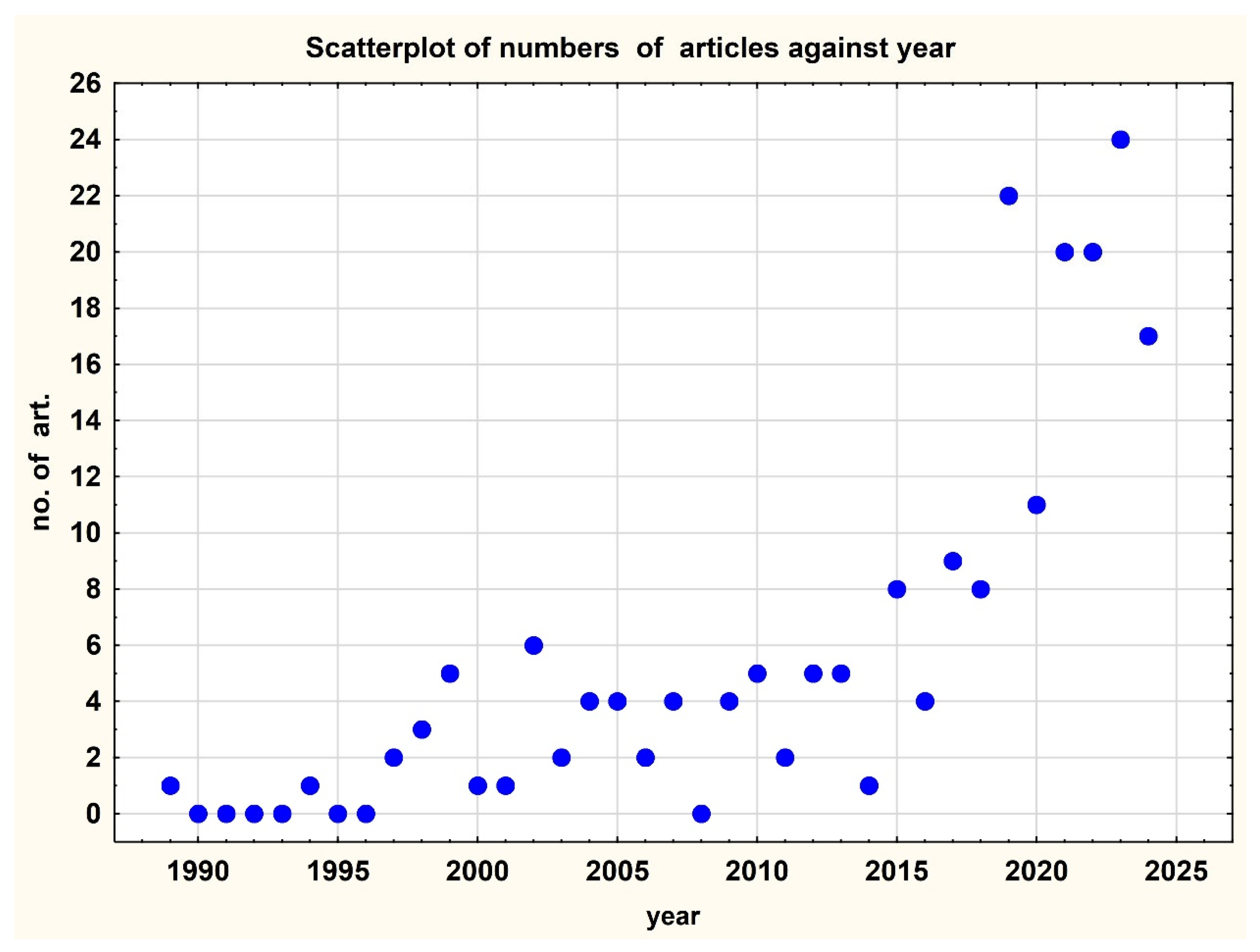
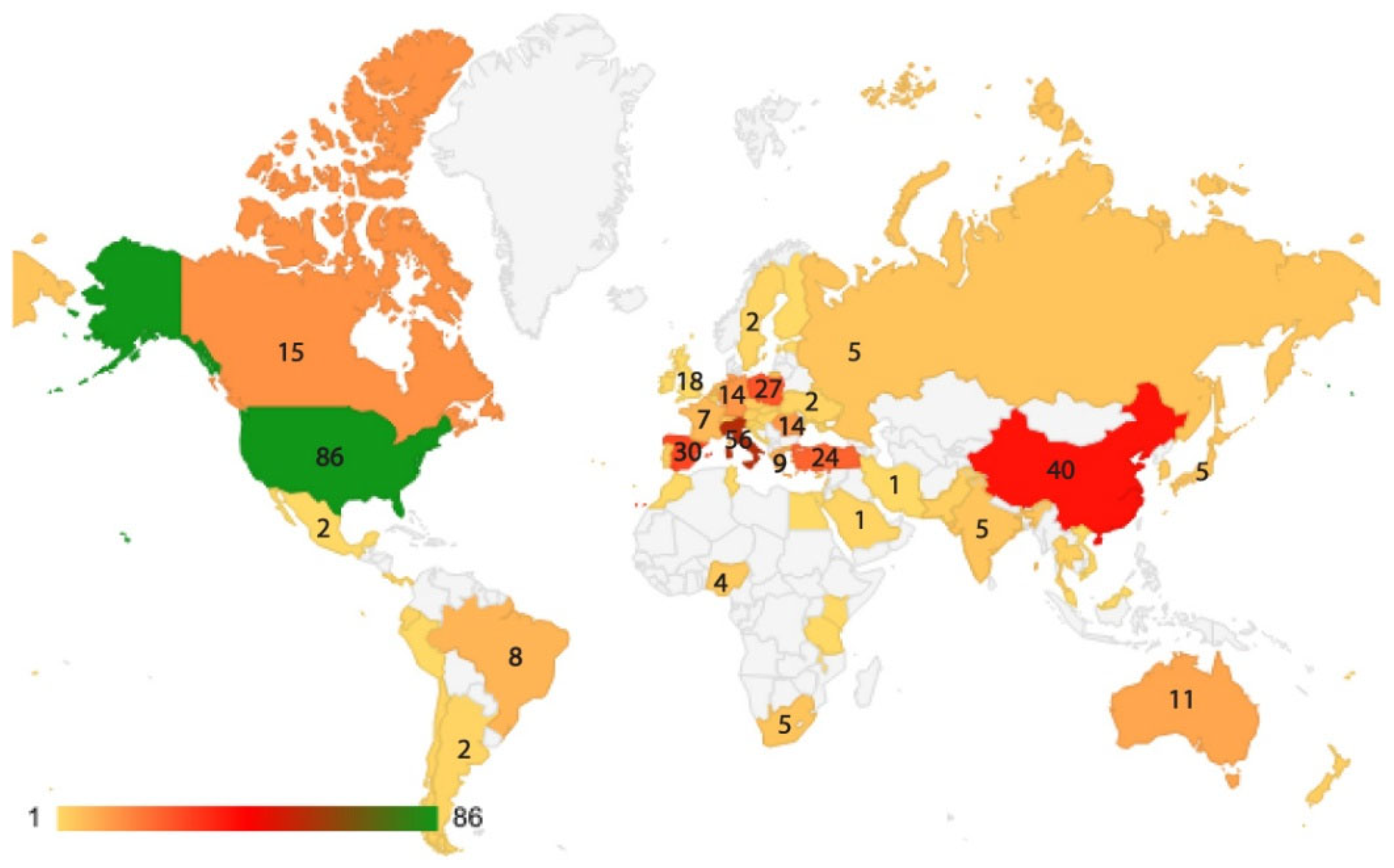
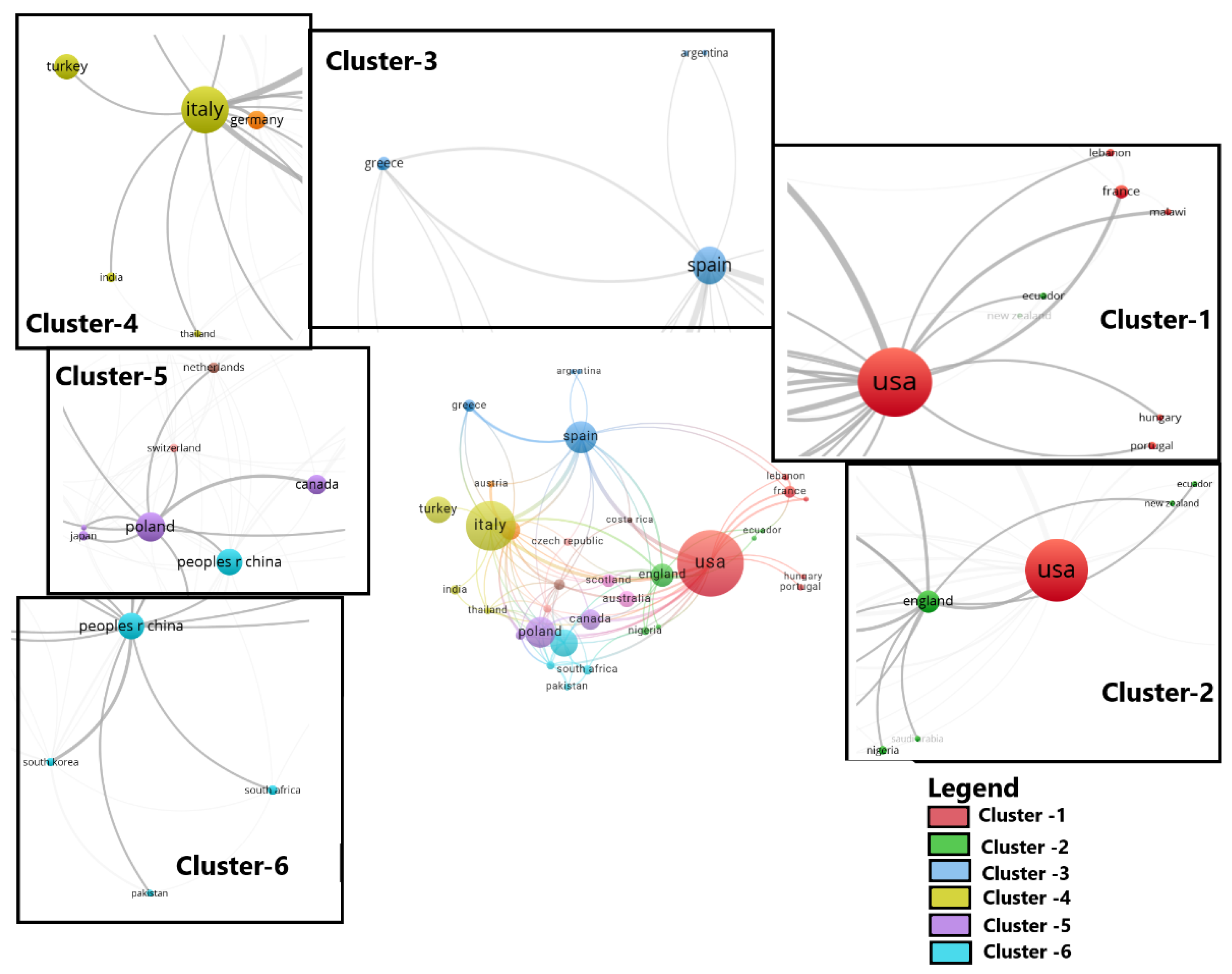


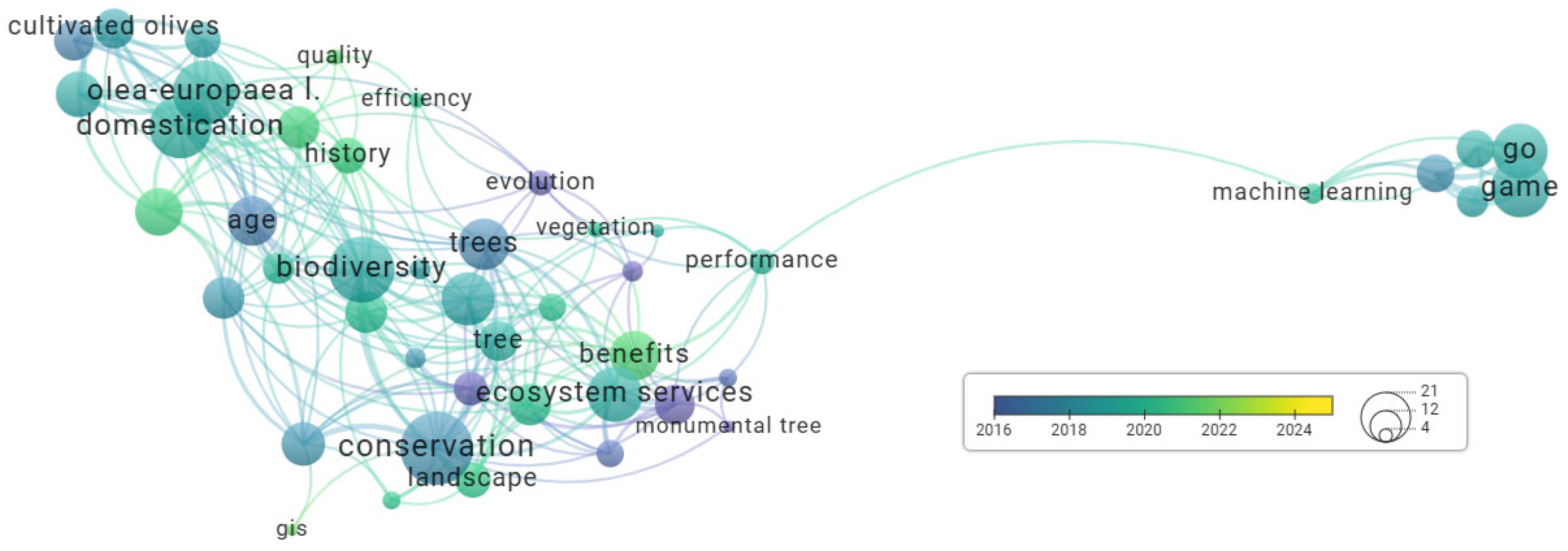
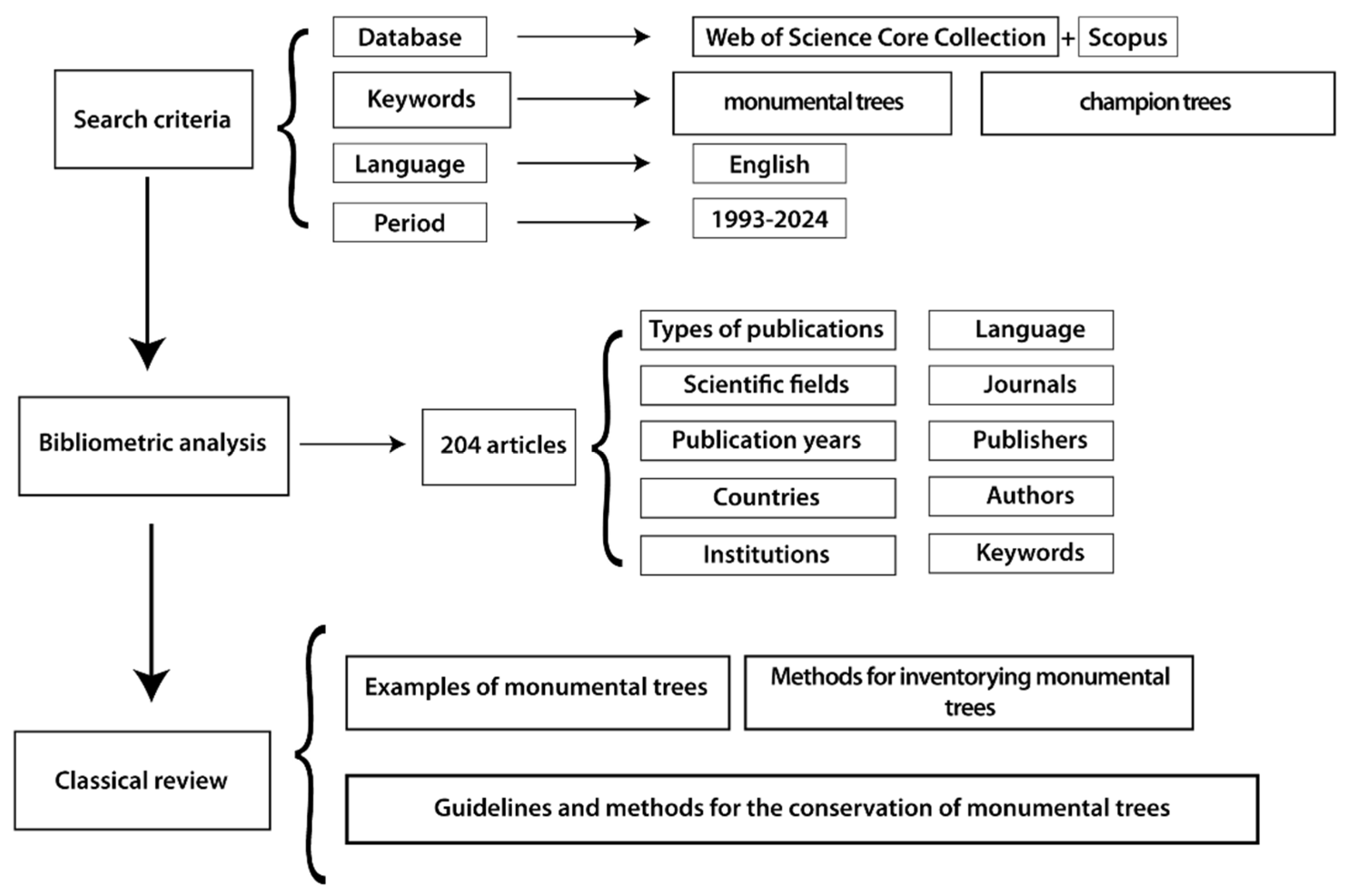
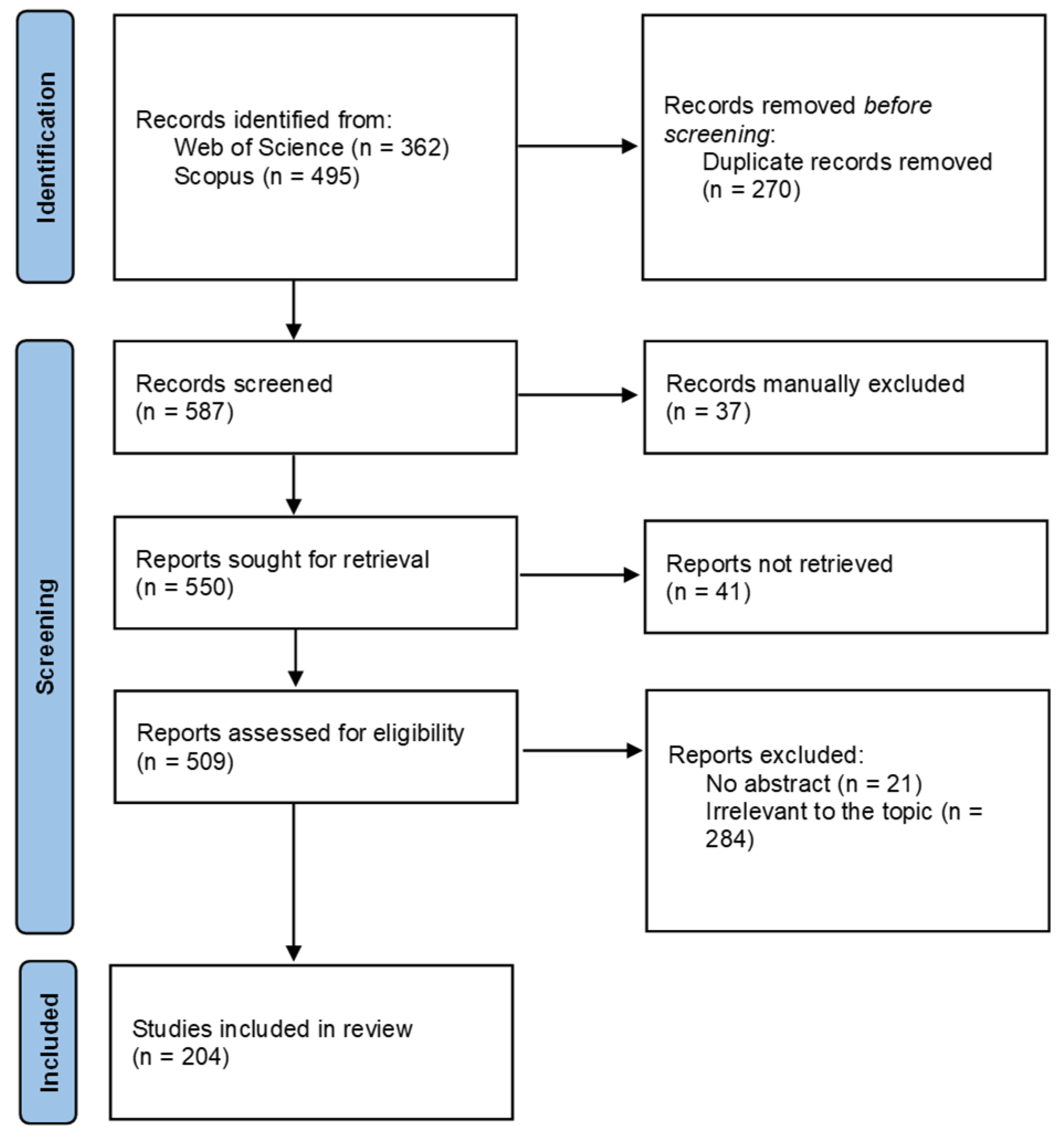
| Cr. No. | Keyword | Occurrences | Total Link Strength |
|---|---|---|---|
| 1 | Conservation | 20 | 34 |
| 2 | Biodiversity | 11 | 30 |
| 3 | Olea europaea | 17 | 29 |
| 4 | Domestication | 8 | 28 |
| 5 | Game | 14 | 26 |
| 6 | Ecosystem services | 8 | 24 |
| 7 | Management | 12 | 23 |
| 8 | Trees | 11 | 22 |
| 9 | Age | 8 | 21 |
| 10 | Benefits | 8 | 21 |
| 11 | Genetic diversity | 7 | 19 |
| 12 | Monumental trees | 18 | 18 |
| 13 | Ancient trees | 6 | 17 |
| 14 | Diversity | 8 | 17 |
| 15 | Dynamics | 8 | 17 |
| 16 | Cultivated olives | 5 | 16 |
| 17 | Tree | 10 | 16 |
| 18 | Urban forest | 7 | 16 |
| 19 | Landscape | 6 | 14 |
| Cur. No. | Monumental Tree Species | Geographical Area | Article Source |
|---|---|---|---|
| 1 | Abies alba Mill. | Garcin, Romania | Vasile et al., 2023 [34] |
| 2 | Abies nordmanniana (Steven) Spach | Mexico | Mejorado Velazco et al., 2020 [35] |
| 3 | Acer pseudoplatanus L. | Romania; China | Vasile et al., 2023; Wang et al., 2023 [34,36] |
| 4 | Acer sempervirens L. | Kuyucak, Turkey | Efe et al., 2014 [37] |
| 5 | Adansonia digitate L. | Mexico | Mejorado Velazco et al., 2020 [35] |
| 6 | Aesculus glabra Willd. | Illinois, USA | Ashley et al., 2022 [38] |
| 7 | Aesculus hippocastanum L. | Brasov, Romania | Vasile et al., 2023 [34] |
| 8 | Ailanthus altissima (Mill.) | Vienna, Austria | Pisova et al., 2023 [39] |
| 9 | Araucaria angustifolia (Bertol.) Kuntze | Brazil | Scipioni, 2019 [40] |
| Bombax malabaricum L. | China | Jim, 2004 [41] | |
| 10 | Buxus sempervirens L. | Vienna, Austria | Pisova et al., 2023 [39] |
| 11 | Carpinus sp. | Białowieża, Poland | Crzywacz et al., 2018 [42] |
| 12 | Castanea sativa Mill. | Artvin, Turkey; Brasov, Romania; Switzerland; Spain; Turkey; Italy; Spain | Temel and Ozalp, 2007 [43]; Vasile et al., 2023 [34]; Krebs et al., 2005 [44]; Gaspar Bernárdez Villegas et al., 2021 [45]; Genc and Guner, 2000 [46]; Schicchi et al., 2021 [47]; Fernández-Lorenzo et al., 2024 [48] |
| 13 | Catalpa bignonioides Walter | Ukraine | Tokarieva et al., 2024 [49] |
| 14 | Ceratonia siliqua L. | Sicily, Italy | Petino et al., 2024 [50] |
| 15 | Fagus sylvatica L. | Brasov, Romania; Sonian Forest, Belgium | Vasile et al., 2023 [34]; Verschuren et al., 2023 [51] |
| 16 | Ficus microcarpa L. f. | Shenzhen, China | Lai et al., 2019 [52] |
| 17 | Fraxinus sp. | Białowieża, Poland | Crzywacz et al., 2018 [42] |
| 18 | Fraxinus udhei (Wenz.) Lingelsh | Mexico | Mejorado Velazco et al., 2020 [35] |
| 19 | Ginkgo biloba L. | Shenzhen, China; Brasov, Romania | Lai et al., 2019 [52]; Li and Zhang, 2021 [53]; Vasile et al., 2023 [25] |
| 20 | Gleditsia triacanthos L. | Vienna, Austria | Pisova et al., 2023 [39] |
| Juniperus excelsa Bieb. | Turkey | Kurtaslan et al., 2012 [54] | |
| Juniperus przewalskii Kom. | China | Liu et al., 2019 [55] | |
| 21 | Juniperus thurifera L. | Soria, Spain | Fuster and Sadornil, 2020 [56] |
| 22 | Larix decidua Mill. | Poland | Meller and Bernat, 2019 [57] |
| 23 | Metasequoia glyptostroboides Hu and W.C.Cheng, 1948 | Ukraine | Tokarieva et al., 2024 [49] |
| 24 | Ocotea porosa (Nees & Martius) Barroso | Brazil | Scipioni, 2019 [40] |
| 25 | Olea europaea L. | Bchaaleh, Lebanon; Spain; Sicily, Italy; Crete, Greece; Cyprus | Camarero et al., 2024 [58]; Arnan et al., 2012 [59]; Marchese et al., 2023 [60]; Bombarely et al., 2021 [61]; Anestiadou et al., 2017 [62] |
| Phoebe zhennan S. Lee & F.N. Wei | China | Yang et al., 2024 [63] | |
| 26 | Picea abies L. Karst | Białowieża Primeval Forest, Poland | Nowakowska et al., 2020 [64] |
| 27 | Pinus nigra subsp. pallasiana | Elemen Plateau of Dirgine in Zonguldak, Turkey | Yaman and Sarıbaș, 2007 [65] |
| 28 | Pinus nigra J.F. Arnold subsp. calabrica (Poir.) | Fallistro, Italy | Bernardini et al., 2020 [66] |
| 29 | Platanus hybrida L. | Pisa, Italy; Spain | Marchica et al., 2017 [67]; Millan et al., 2025 [68] |
| 30 | Platanus orientalis L. | Istanbul, Turkey; Greece | Yener, 2022 [69]; Kagiali and Tsitsoni, 2019 [70]; Grigoriadis et al., 2021 [71] |
| 31 | Populus nigra L. | Jaworze, Poland | Pietraszko et al., 2022 [72] |
| 32 | Pyrus communis L. | Poland | Kimic, 2021 [73] |
| 33 | Quercus infectoria | Edremit, Turkey | Efe et al., 2011 [74] |
| 34 | Quercus robur L. | Jasienica, Poland | Pietraszko et al., 2022 [72] |
| 35 | Quercus hartwissiana Stev. | Turkey | Gul et al., 1999 [75] |
| 36 | Rhododendron myrtifolium Schott & Kotschy, 1851 | Ukraine | Tokarieva et al., 2024 [49] |
| 37 | Sambucus nigra L. | Vienna, Austria | Pisova et al., 2023 [39] |
| 38 | Sequoiadendron giganteum (Lindl.) J.Buchh, 1939 | Czech Republic | Dreslerova, 2017 [15] |
| 39 | Sorbus torminalis (L.) Crantz | Kyiv, Ukraine | Prokopuk et al., 2022 [76] |
| 40 | Taxodium Mucronatum Ten. | Mexico | Mejorado Velazco et al., 2020 [35] |
| 41 | Taxus baccata L. | Thasos, Greece; Jaworze, Poland; | Malliarou et al., 2023 [77]; Pietraszko et al., 2022 [72] |
| 42 | Taxus chinensis (Rehder & E.H.Wilson) Rehder | Shenzhen, China | Lai et al., 2019 [52] |
| 43 | Thuja plicata Donn ex D. Don | Canada | Benner et al., 2019 [78] |
| 44 | Tilia cordata Mill. | Jasienica, Poland | Pietraszko et al., 2022 [72] |
| 45 | Tilia platyphyllos Scop. | Czech Republic | Dreslerova, 2017 [15] |
| Ziziphus jujuba Mill. | China | Pan et al., 2025 [79] |
Disclaimer/Publisher’s Note: The statements, opinions and data contained in all publications are solely those of the individual author(s) and contributor(s) and not of MDPI and/or the editor(s). MDPI and/or the editor(s) disclaim responsibility for any injury to people or property resulting from any ideas, methods, instructions or products referred to in the content. |
© 2025 by the authors. Licensee MDPI, Basel, Switzerland. This article is an open access article distributed under the terms and conditions of the Creative Commons Attribution (CC BY) license (https://creativecommons.org/licenses/by/4.0/).
Share and Cite
Budău, R.; Timofte, C.S.C.; Mirisan, L.V.; Bei, M.; Dinca, L.; Murariu, G.; Racz, K.A. Living Landmarks: A Review of Monumental Trees and Their Role in Ecosystems. Plants 2025, 14, 2075. https://doi.org/10.3390/plants14132075
Budău R, Timofte CSC, Mirisan LV, Bei M, Dinca L, Murariu G, Racz KA. Living Landmarks: A Review of Monumental Trees and Their Role in Ecosystems. Plants. 2025; 14(13):2075. https://doi.org/10.3390/plants14132075
Chicago/Turabian StyleBudău, Ruben, Claudia Simona Cleopatra Timofte, Ligia Valentina Mirisan, Mariana Bei, Lucian Dinca, Gabriel Murariu, and Karoly Alexandru Racz. 2025. "Living Landmarks: A Review of Monumental Trees and Their Role in Ecosystems" Plants 14, no. 13: 2075. https://doi.org/10.3390/plants14132075
APA StyleBudău, R., Timofte, C. S. C., Mirisan, L. V., Bei, M., Dinca, L., Murariu, G., & Racz, K. A. (2025). Living Landmarks: A Review of Monumental Trees and Their Role in Ecosystems. Plants, 14(13), 2075. https://doi.org/10.3390/plants14132075










